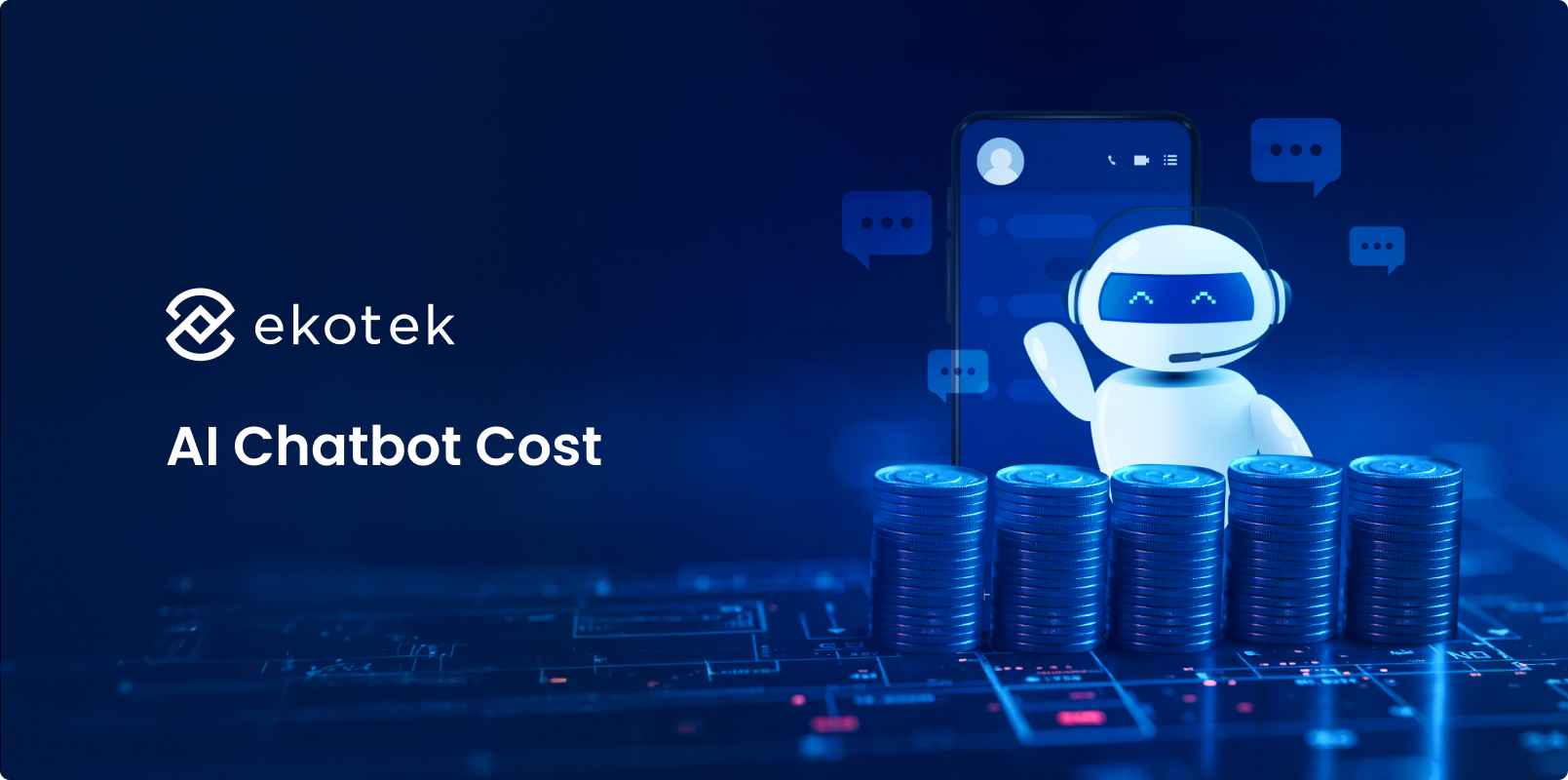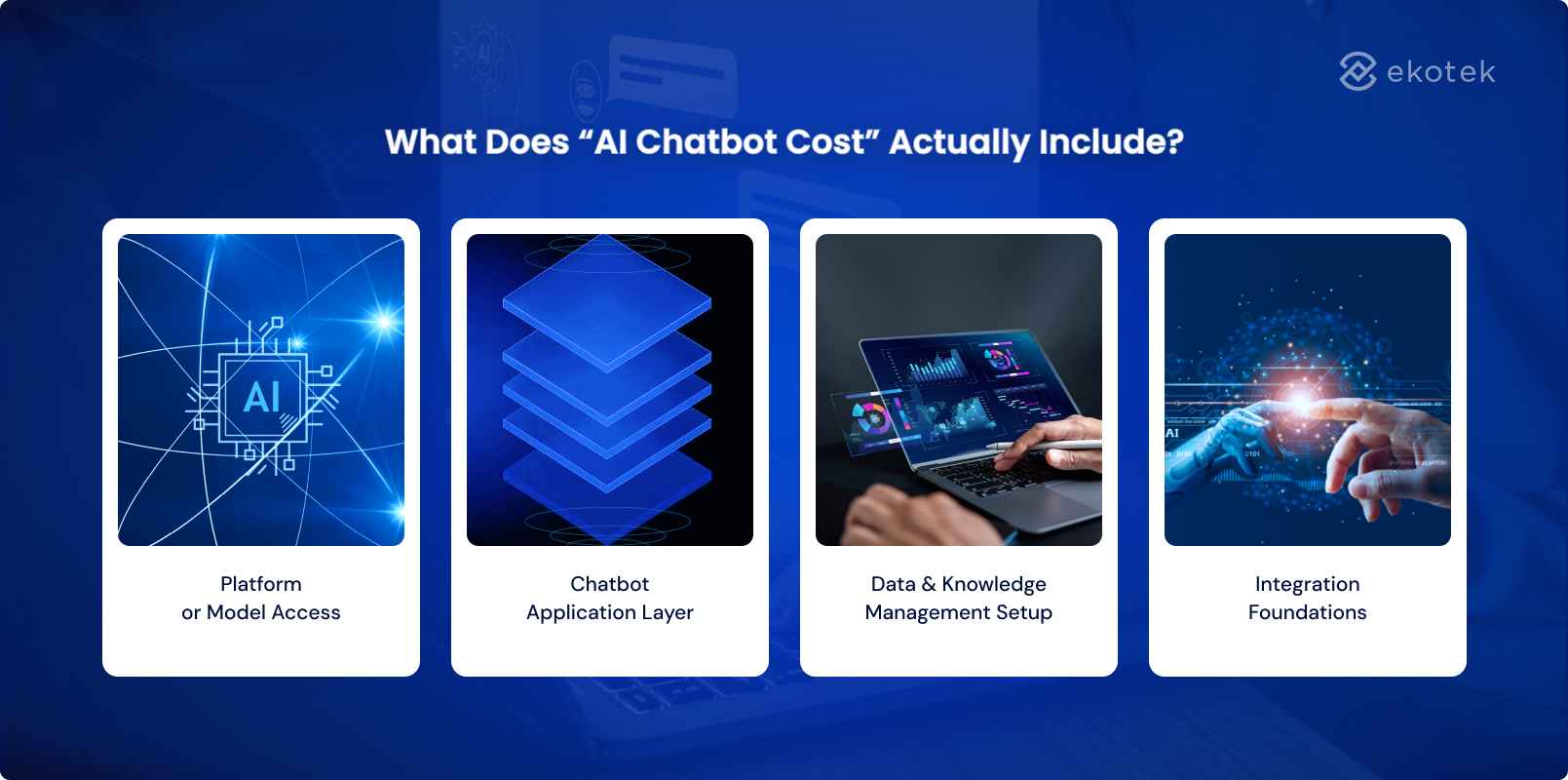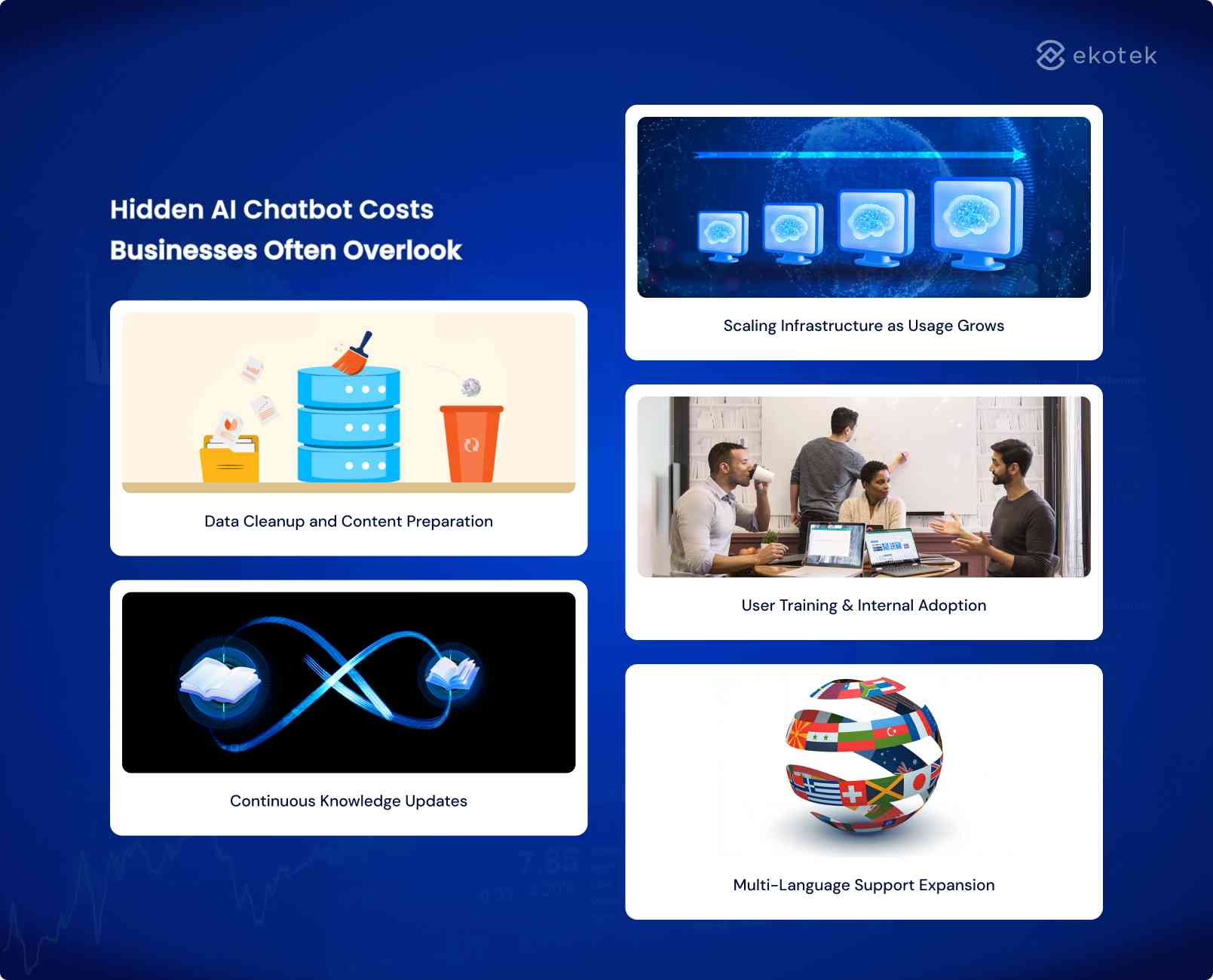
- 1
- 2
- 3
- 4
- 5
- 6
- 7
- 8
- 9
- 10
Introduction
As AI adoption grows across industries, organizations are increasingly exploring AI chatbots to improve efficiency, customer experience, and operational scalability. Naturally, one of the first questions leaders ask is: What is the real AI chatbot cost?
The truth is that the cost involves much more than a subscription fee. It includes development, integrations, infrastructure, model usage, maintenance, and long-term optimization. This guide gives businesses a clear starting point to understand the full cost landscape before investing.
What Does “AI Chatbot Cost” Actually Include?
When calculating AI chatbot cost, businesses often overlook how many layers are involved beyond the model itself. In an enterprise environment, the total cost typically spans four core components:
Platform or Model Access
This includes fees for accessing large language models (LLMs) or chatbot platforms. Costs may be based on token usage, API calls, request volume, or enterprise licensing tiers, depending on whether you use OpenAI, Anthropic, Claude, or a vendor-provided model.
Chatbot Application Layer
Beyond the model, every chatbot requires an application layer: conversation flows, UI/UX, guardrails, workflows, business logic, and monitoring tools. Building and maintaining this layer contributes significantly to overall cost.
Data & Knowledge Management Setup
To deliver accurate answers, the chatbot must connect to structured and unstructured data. This includes preparing documents, setting up embeddings or vector databases, configuring retrieval pipelines, and establishing content governance.
Integration Foundations
Finally, enterprise chatbots rely on robust integration work. Connecting to CRMs, ERPs, internal tools, authentication systems, or APIs requires development time, testing, and security reviews, making it one of the largest cost drivers.
📌 You may be interested in Chatbot vs Conversational AI
 Key Cost Models for AI Chatbots
Key Cost Models for AI Chatbots
Every B2B procurement team must decide not just which AI chatbot to deploy, but which payment model aligns with their business goals. Choosing the wrong model isn’t just a theoretical risk, it can quickly result in bottlenecked growth or out-of-control expenses.
There are four primary cost models in the AI chatbot arena:
SaaS Subscription Model
- Structure: Fixed monthly or annual payment, generally per workspace or “seat.”
- Budget Predictability: High
- Scale: Rapid onboarding; best for standard chat, FAQs, or small to midsize use.
- Example: Boei AI at €149/month; Intercom ranging from $99–$499/month.
Usage-Based (Per-Conversation/Interaction)
- Structure: Pay per message, conversation, or active user.
- Budget Predictability: Variable, can spike with demand.
- Scale: Suits firms with fluctuating volumes or project-based needs.
- Example: IBM Watson combines base subscription plus usage-based escalators; large contracts may blend both elements.
One-Time Custom Build
- Structure: Significant upfront payment with optional maintenance add-ons.
- Budget Predictability: Medium to high, but large initial outlay.
- Scale: Ideal for deeply integrated or highly regulated verticals.
- Example: Ekotek AI chatbot solutions from $10,000 to $85,000+, especially for legacy or compliance-heavy needs.
Hybrid Model
- Structure: SaaS core with custom overlays, integration, or on-demand premium support services.
- Budget Predictability: Ranges from predictable (base) to variable (custom or add-ons).
- Scale: Flexible path for scaling from pilot to enterprise.
📌 Learn more about How much does AI cost
Factors That Influence AI Chatbot Cost
The total AI chatbot cost can vary widely depending on how complex your use case is and how deeply the chatbot needs to integrate into your business workflows. For businesses, where accuracy, compliance, and scalability are critical, several key factors directly impact cost.
Use Case Complexity
Simple Q&A or FAQ chatbots cost far less than agents that perform actions, retrieve data, or support multi-step workflows. The more reasoning, automation, or domain expertise required, the higher the development and model usage cost.
Level of Customization
Off-the-shelf chatbots are cheaper but limited. Custom features, fine-tuned models, tailored prompts, company-specific training data, or advanced UI, add cost but drastically improve performance in enterprise settings.
Integrations With Business Systems
Connecting the chatbot to CRMs, ERPs, databases, knowledge bases, or authentication systems is often one of the biggest cost drivers. The more systems involved, the more development, testing, and security work is needed.
📌 Check out this guide on AI integration
Model Choice and Usage Volume
Large, high-performance LLMs cost more per token. High-traffic environments or use cases like customer support can rapidly increase monthly expenses. Choosing the right model tier is essential for cost control.
Security, Compliance, and Data Governance
Enterprises may require advanced controls, SSO, RBAC, encryption, audit logs, SOC 2/ISO alignment, which add to development and licensing costs.
Ongoing Maintenance and Optimization
AI chatbots are not “set and forget.” They require monitoring, prompt updates, retraining, analytics, and continuous improvement, all of which contribute to long-term operational cost.
Hidden Costs Businesses Often Overlook
Even with a clear budget, many organizations underestimate the long-term costs tied to AI chatbot operations. Below are the hidden expenses that frequently surface only after deployment.
Data Cleanup and Content Preparation
Before the chatbot can perform reliably, internal documents and knowledge sources must be cleaned, structured, and standardized.
- Removing outdated or duplicated content
- Formatting documents for retrieval
- Aligning knowledge sources across departments
Scaling Infrastructure as Usage Grows
As chatbot adoption increases, infrastructure requirements expand.
- Higher vector database storage
- Additional compute for inference
- Upgrading plans or server capacity to handle peak loads
User Training & Internal Adoption
Getting teams to use the chatbot effectively requires ongoing enablement.
- Training sessions for different roles
- Internal documentation and best practices
- Change management efforts to ensure consistent adoption
Multi-Language Support Expansion
Supporting additional languages introduces extra cost beyond translation.
- Higher model usage due to multilingual prompts
- Additional evaluation and quality checks
- Language-specific tuning to maintain accuracy
Ekotek’s customer-support chatbot for an e-commerce company shows how multi-language capability adds extra development and testing effort. The chatbot automatically detects user language, English or otherwise, and responds appropriately. This flexibility improves global support but also increases model usage and quality assurance costs.
📌 Explore how we built a round-a-clock AI chatbot
Continuous Knowledge Updates
Information changes quickly, and the chatbot must stay current.
- Regularly updating knowledge bases
- Adding new datasets or product information
- Monitoring and fixing outdated responses
 How to Estimate AI Chatbot ROI
How to Estimate AI Chatbot ROI
Estimating the ROI of an AI chatbot is essential for B2B leaders who need to justify investment and align it with long-term business goals. While AI benefits can feel abstract, a clear ROI framework helps translate outcomes into measurable financial impact.
Identify the Costs You’re Trying to Offset
Start by mapping the current expenses the chatbot will reduce or replace.
-
Labor hours for customer support or internal teams
-
Costs of manual data entry or repetitive tasks
-
Delays caused by slow response times or human bottlenecks
Quantify Productivity Gains
AI chatbots can automate interactions at scale. Estimate:
-
Time saved per task or inquiry
-
Number of tasks automated per month
-
Reduction in workload for high-skill employees
Measure Improvements in Response Quality and Speed
Faster, more accurate responses can drive meaningful operational benefits.
-
Higher customer satisfaction and retention
-
Fewer escalations to human agents
-
Improved internal decision-making speed
Estimate Revenue Impact
Chatbots don’t just save money, they can generate it.
-
Increased lead qualification and conversion
-
More upsell/cross-sell opportunities
-
24/7 availability enabling new customer touchpoints
Factor in Long-Term Scalability
The ROI often grows over time as usage increases.
-
Cost per interaction decreases at scale
-
The chatbot can expand across departments without proportionally increasing cost
Compare Total Benefits to Total Cost
Finally, calculate ROI with a simple formula:
ROI = (Total Annual Benefits – Total Annual Costs) / Total Annual Costs
Cost Comparison: Building In-House vs. Using a Vendor
Many CTOs and finance leads face the boardroom question: “Why not develop our AI chatbot in-house for total control?” The answer isn’t always obvious, especially when balancing budget, resources, and speed-to-market.
In-House Build Pros:
- Absolute control over features, data, and compliance.
- Potential for tailored integration and innovation.
In-House Build Cons:
- Significant upfront R&D investment, custom builds routinely run $30,000–$85,000+ for feature parity (in-house development).
- Extended time-to-value, internal teams require months to architect, code, and QA.
- Ongoing maintenance risk falls solely on internal resources.
Vendor Model Pros:
- Rapid deployment, SaaS platforms like Boei AI and Intercom go live in days or weeks, not months.
- Immediate access to robust features, support, platform enhancements.
- Predictable cost structure, easier scaling.
Vendor Model Cons:
- Functional lock-in, custom business rules may not be supported.
- Long-term TCO for large-scale or niche requirements can surpass a well-managed in-house build.
Hybrid Path: Many B2Bs, especially those with legacy systems or unique workflows, select a SaaS vendor as a foundation, adding custom logic and features via specialized partners like Ekotek Technology.
📌 Dive into AI outsourcing guide
Build vs. Buy Matrix
| Feature Category | In-House | Vendor/SaaS |
|---|---|---|
| Setup Cost | High (> $30K) | Low ($99–$499/mo) |
| Time to Value | 4–12 months | Immediate–4 weeks |
| Customization | Full | Pre-built, some custom |
| Scalability | Resource-based | On-demand, elastic |
| Maintenance | Internal team | Vendor, SLA-based |
| Compliance | Custom setup | Platform-dependent |
How to Choose the Right AI Chatbot for Your Business
Selecting the right AI chatbot goes far beyond price tags. Features, compliance, integration, support, and the vendor’s track record in regulated industries all weigh heavily on risk management and ROI. Here’s how smart B2B buyers streamline the process, using Ekotek Technology as a reference case.
Needs Assessment:
Begin with a granular review of business priorities: volume, compliance, languages, escalation logic (e.g., must-support human fallback).
Model Filtering:
Shortlist only those providers and models (SaaS, usage, hybrid, custom) aligned to your technical and budget profile (chatbot platform evaluation).
Vendor Vetting:
Examine experience in your vertical, review client references, third-party ratings (e.g., Ekotek Technology scores 4.9+ on Clutch), and audit compliance credentials (regulated industries).
PoC/Testing:
Pilot across edge-case scenarios, integration points, and real-user workflows. Example: Ekotek Technology recently led a multinational manufacturing PoC, delivering multilingual escalation and real-time SAP integration within six weeks.
Negotiation & Roll-Out:
Clarify all costs (fixed and potential hidden), finalize vendor checklist (onboarding, exit, upgrades), and prepare for rollout.
📌 Learn about AI agent vs chatbot differences
 Conclusion
Conclusion
Understanding AI chatbot cost requires more than looking at subscription fees. Leaders need to evaluate all cost components, platform usage, integrations, security, and ongoing optimization. Hidden expenses such as data preparation, QA, and scalability also play a major role in long-term budgeting. And ultimately, ROI should be measured not only through cost savings but also through productivity gains and revenue impact. With a clear framework, businesses can make confident, strategic decisions when adopting AI chatbots.
If you’re looking for a trusted technology partner, Ekotek is a leading software development company in Vietnam specializing in AI, blockchain, and digital transformation. Our team has deep expertise in AI and extensive experience building solutions across manufacturing, banking & finance, education, and more. Ekotek provides end-to-end services including AI chatbots, computer vision, generative AI, agentic AI, and AI integration. We also offer ready-made AI solutions that help businesses accelerate time-to-market while still allowing full customization to meet specific requirements.
FAQ on AI chatbot cost
1. How long does it typically take to see cost benefits from an AI chatbot?
Most businesses begin seeing measurable cost benefits within 2-3 months after deployment, once the chatbot has stabilized, learned common interactions, and started reducing manual workload consistently.
2. Do AI chatbots cost more for multilingual support?
Yes. Supporting multiple languages often requires additional model usage, translation layers, or language-specific fine-tuning. The more languages required, the higher the operational cost.
3. Is there a cost difference between using a cloud-hosted AI chatbot and an on-premise one?
Generally, cloud-hosted solutions have lower upfront costs but ongoing usage fees. On-premise deployments require higher initial investment for infrastructure and maintenance but may reduce long-term operational expenses.
4. Can AI chatbot cost increase if the business expands to new markets or departments?
Absolutely. Expansion often leads to higher conversation volume, more integrations, and additional training data, each of which can increase the overall cost as the system scales.
- 1
- 2
- 3
- 4
- 5
- 6
- 7
- 8
- 9
- 10